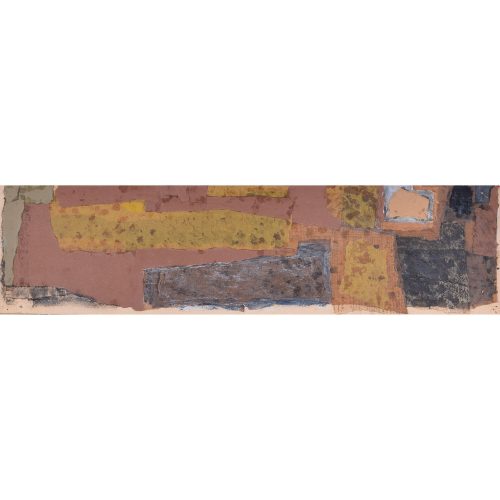-
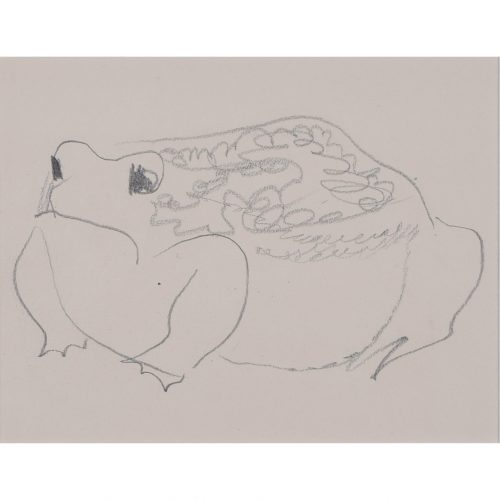
Clifford Ellis (1907-1985)
Bufo the Toad
Pencil, 1950s 11x14cm In a Nicholson butt-jointed frame Provenance: the family of the artist, by descent. Click here for biographical details and other works by the artist. Clifford and Rosemary Ellis were famous as a husband and wife team for their fascination with nature and their vibrant and charming depictions of animals. They were the natural artists to be commissioned by Collins for their 'New Naturalists' series of books, which have become famous and highly collectable more for the dust jackets designed by the Ellises than for the - otherwise excellent - content. This painting is from a recently discovered series of paintings and drawings, never before seen by the general public, dating from the 1940s and 1950s. "Old Bufo is the biggest Toad. He is very tame and always knows that when I make a special scratching noise he will get fed." Clifford and Rosemary wrote a series of illustrated books for young children including this one featuring Bufo. Although never published they are now held by the Victoria Art Gallery in Bath. If you are interested email info@manningfineart.co.uk or call us on 07929 749056. -
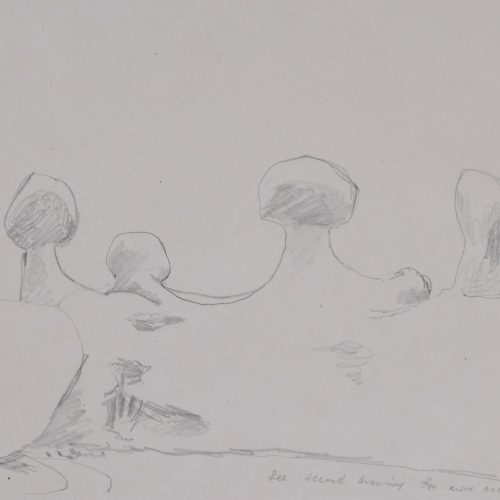
Clifford Ellis (1907-1985) Broad Chalke, Wiltshire
20x33cm Carbon pencil Provenance: the family of the artist, by descent. Born in Bognor in Sussex and trained at St Martin’s School of Art and Regent Street Polytechnic, Ellis was a graphic artist and illustrator who is best known for the posters he produced for London Transport during the 1930s. He generally collaborated with his wife Rosemary – whom he married in 1931 – on their posters. The General Post Office, Shell, and The Empire Marketing Board were also clients for their posters. They signed their posters C&RE, their initials being in alphabetical order and they are readily recognisable by their ebullient use of colour and form. Employed during the war as a camoufleur, along with so many other artists, Clifford was also an official war artist, serving with the Grenadier Guards. Rosemary, meanwhile, was an artist for the Recording Britain project. Following the war they trained art teachers at Bath Academy of Art. They also designed a series of nearly one hundred book jackets for Collins New Naturalist series, published between 1945 and 1982 and were always fascinated by animals and natural history, as with this sketch. If you are interested email info@manningfineart.co.uk or call us on 07929 749056. Condition: Generally very good. -

Clifford Ellis (1907-1985)
Autumn in Yellow and Brown
Gouache 27x15cm Provenance: the family of the artist, by descent. Click here for biographical details and other works by the artist. If you are interested email info@manningfineart.co.uk or call us on 07929 749056. -

Clifford Ellis (1907-1985)
Abstract in Grey I
Gouache 21x12cm Provenance: the family of the artist, by descent. Click here for biographical details and other works by the artist. If you are interested email info@manningfineart.co.uk or call us on 07929 749056. -
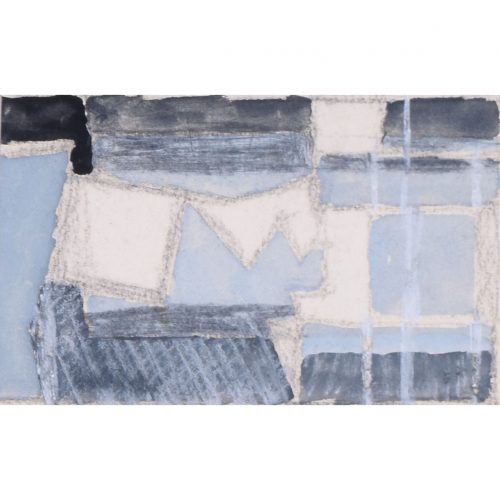
Clifford Ellis (1907-1985)
Grey Abstract
Gouache 10x18cm Provenance: the family of the artist, by descent. Click here for biographical details and other works by the artist. If you are interested email info@manningfineart.co.uk or call us on 07929 749056. -
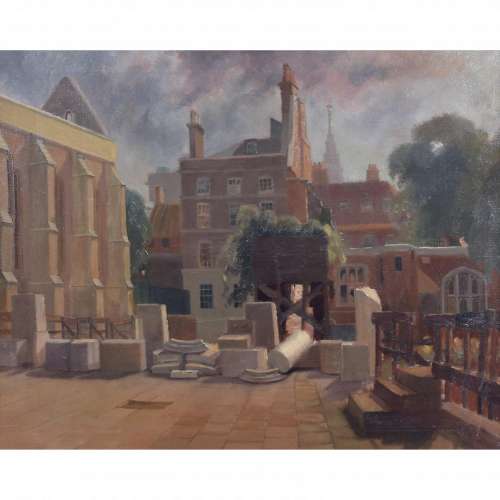
Clifford Charman (1910-1993)
Temple Church, London, after Bombing
Oil on canvas 39 x 49 cm Provenance: The Artist's Studio Sale, Bonhams, London (18 March 1993); Peter Constant Fine Art. Born in Bexleyheath in Kent, Charman studied at Regent Street Polytechnic just before, and just after, the Second World War. He exhibited widely, including at the Royal Academy, the RBA, Chelsea Arts Society, and abroad. Elected in 1954 to the ROI, he also won the James Bourlet Prize in 1982. His work is in collections including that of the Guildhall. If you'd like to know more, please email info@manningfineart.co.uk or call us on 07929 749056. Condition: Generally very good. -
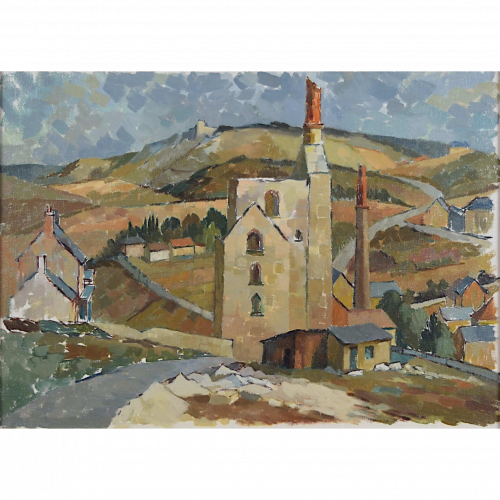
Clifford Charman (1910-1993)
Landscape with Farmhouses
Oil on canvas 38 x 55 cm Provenance: the artist's studio sale, Bonhams, London 1993. Born in Bexleyheath in Kent, Charman studied at Regent Street Polytechnic just before, and just after, the Second World War. He exhibited widely, including at the Royal Academy, the RBA, Chelsea Arts Society, and abroad. Elected in 1954 to the ROI, he also won the James Bourlet Prize in 1982. His work is in collections including that of the Guildhall. If you'd like to know more, please email info@manningfineart.co.uk or call us on 07929 749056. Condition: Generally very good. -
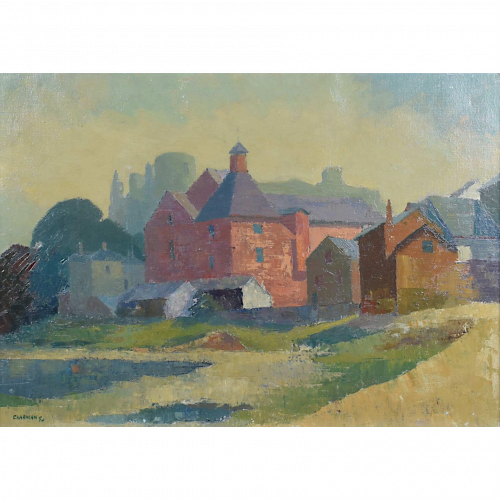
Clifford Charman (1910-1993)
Brewery and Ruined Castle, Cockermouth
Oil on canvas 38 x 55 cm Signed and dated lower left. Provenance: The Artist's Studio Sale, Bonhams, London (18 March 1993); Peter Constant Fine Art. Born in Bexleyheath in Kent, Charman studied at Regent Street Polytechnic just before, and just after, the Second World War. He exhibited widely, including at the Royal Academy, the RBA, Chelsea Arts Society, and abroad. Elected in 1954 to the ROI, he also won the James Bourlet Prize in 1982. His work is in collections including that of the Guildhall. If you'd like to know more, please email info@manningfineart.co.uk or call us on 07929 749056. Condition: Generally very good. Signed lower left. -
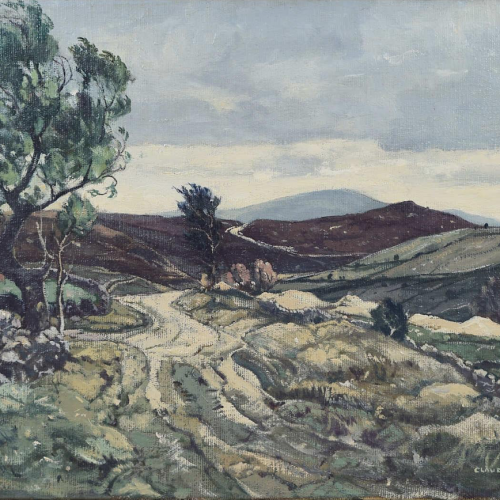
Claude Muncaster Moor above Llangollen
Oil on canvas 36 x 51 cm Condition: Excellent, recently cleaned and revarnished. Signed lower right. Click here for biographical details and other works by the artist. If you are interested, email info@manningfineart.co.uk or call us on 07929 749056. -
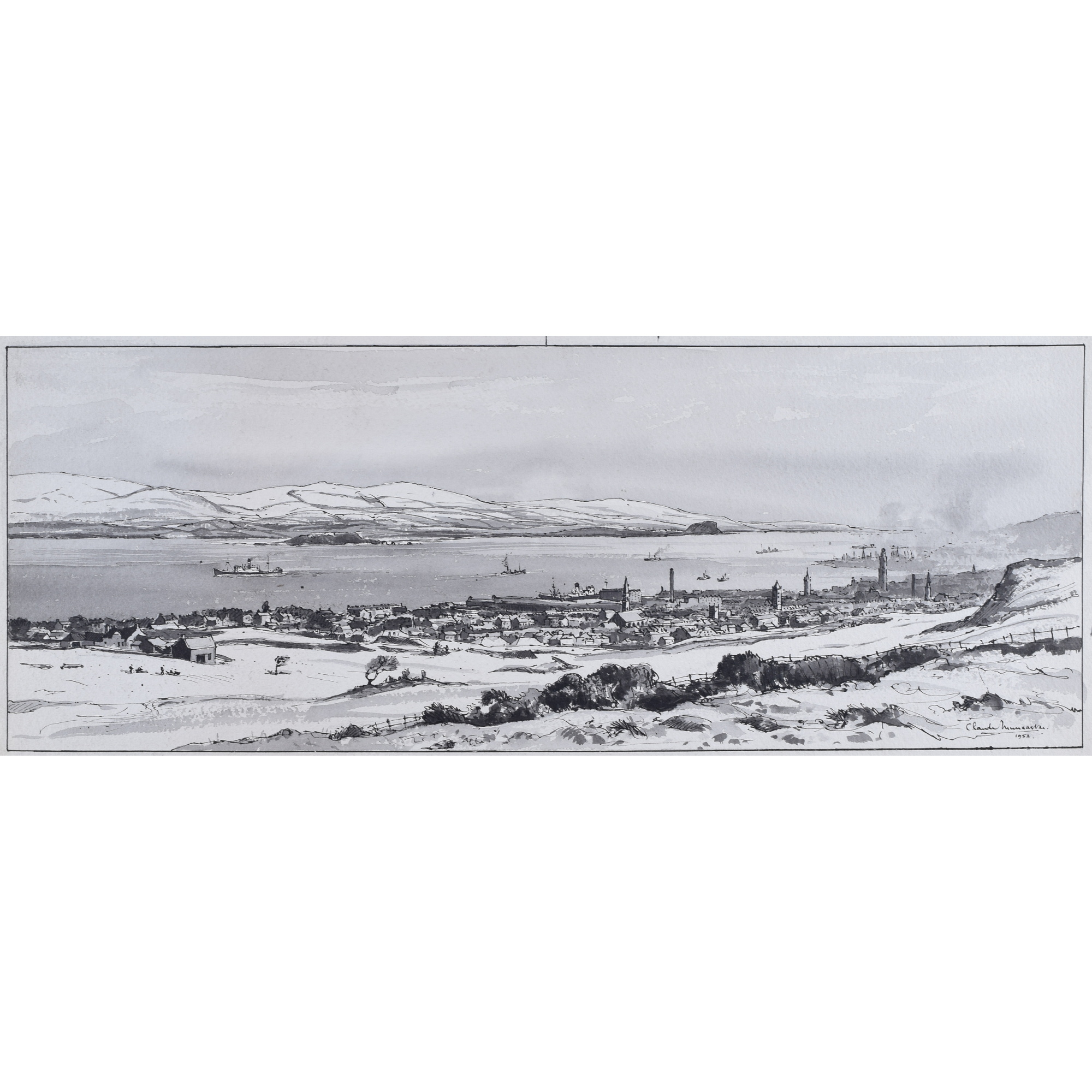
Claude Muncaster (1903-1974)
View of the Clyde from Lyle Hill
Monochrome watercolour with ink Signed and dated 1952, and inscribed 'Sphere' 18x50cm DRAWN FOR 'THE SPHERE' ILLUSTRATED MAGAZINE Click here for biographical details and other works by the artist. If you are interested email info@manningfineart.co.uk or call us on 07929 749056. -
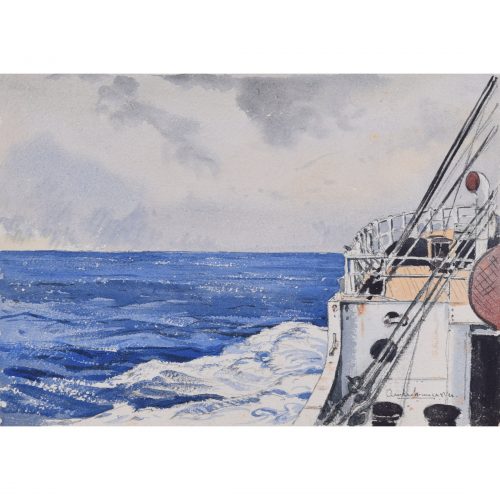
Claude Muncaster
The Bow Wash
Pen and watercolour 21x28cm Framed Provenance: Martin Muncaster, the artist's son. Click here for biographical details and other works by the artist. If you are interested email info@manningfineart.co.ukor call us on 07929 749056. -
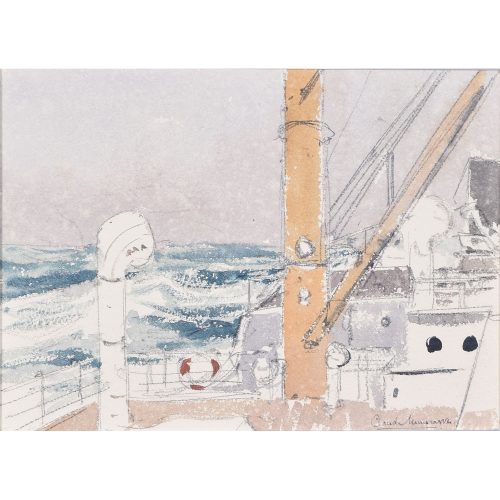
Claude Muncaster
Storm on City of Exeter, Ellerman Line (Passing through the Bay of Biscay), 1948
Signed Watercolour and pencil 21x28cm Provenance: Martin Muncaster, the artist's son. Click here for biographical details and other works by the artist. If you are interested email info@manningfineart.co.uk or call us on 07929 749056. -
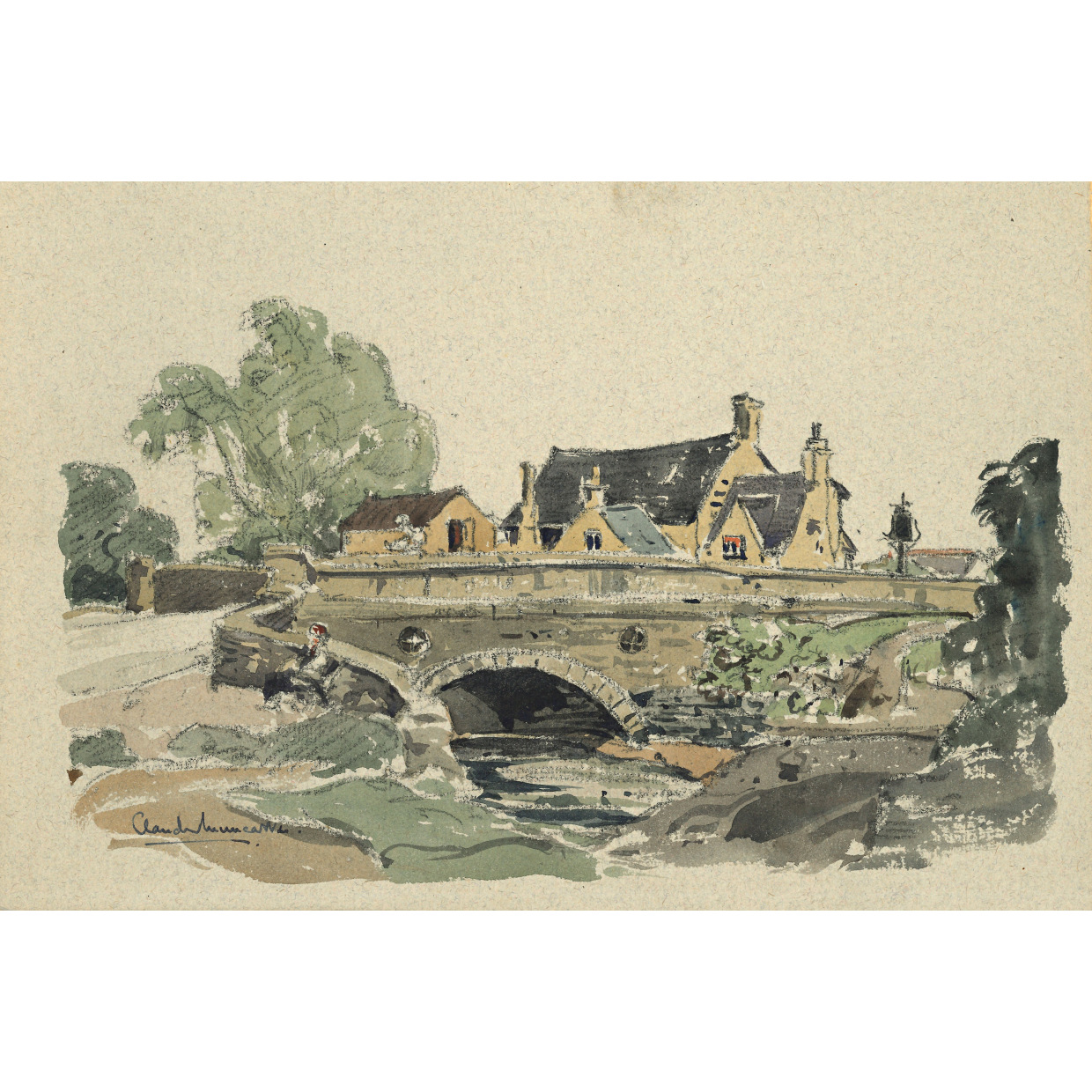
Claude Muncaster (1903-1974)
The Old George Inn South Cerney
Dated October 1952 to reverse Signed lower left and further signed to reverse Pencil and Watercolour 20x30cm Muncaster's watercolours capture the English countryside feel with great competence. Click here for biographical details and other works by the artist. If you are interested email info@manningfineart.co.uk or call us on 07929 749056. -
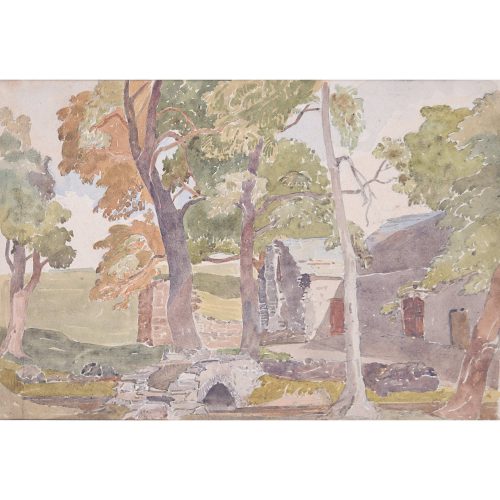
Claude Muncaster (1903-1974) Shap Farmhouse
Watercolour 19 x 29 cm Signed and inscribed to reverse. Here Muncaster records a farmhouse in the Market Town of Shap in Cumbria. This remote village has had a market charter since the seventeenth century. Claude Grahame Muncaster, RWS, ROI, RBA, SMA was the son of Oliver Hall RA. At the age of fifteen his career as a landscape painter began, and he soon took to the seas, spending the 1920s and 30s travelling the world with his sketchbook in a series of vessels. With the outbreak of war and he joined the RNVR training as a navigator. Having left school at fifteen his mathematics was very weak and it was a relief for all when his artistic talents meant he was recruited as a camofleur. A master of capturing seascapes he was therefore able to hide huge ships ‘in plain sight’ with clever disguises. After the war he painted for the Royal Family and was a frequent guest at Sandringham. Claude Muncaster was a watercolourist known for his landscapes and maritime scenes. He was born Grahame Hall, the son of the Royal Academician Oliver Hall who taught his son to paint from an early age; Grahame first exhibited his work aged 15 and a few years later was showing at the RA. However, he adopted the name Claude Muncaster in 1922 to dissociate his career from that of his father. Muncaster’s primary choice of subject matter came from a genuine love of the sea. He made several long-distance sea voyages, including one around the Horn as a deckhand in the windjammer Olivebank in 1931, which he described in ‘Rolling Round the Horn’, published in 1933. Armed with a sketchbook, his aim was to be able to ‘paint ships and the sea with greater authority’. This he certainly achieved, perfectly capturing the limpid first light of morning over the Port of Aden, the choppy rain-grey waters of the Bay of Biscay and a streak of sunlight through gathering storm clouds at dusk in Exeter. He became an Associate of the Royal Watercolour Society in 1931 and was a founder member, and later President, of the Royal Society of Marine Artists. During the Second World War, Muncaster served in the Royal Naval Volunteer Reserve (RNVR) from 1940-44, training as a navigator before going on to advise on the camouflage of ships, and also worked as an official war artist. In ‘Still Morning at Aden’ (1944) he depicts Allied warships in this safe anchorage in the Middle East; the back is stamped with Admiralty approval. In 1946-7 he was commissioned by the Queen to produce watercolours of the royal residences at Windsor, Sandringham and Balmoral; the Duke of Edinburgh, in a foreword to a biography of Muncaster, recalls looking at these and considering the artist’s ‘unerring instinct for a subject’, his sense of atmosphere. Other commissions included large panoramas of the Thames and of Bradford. His career also included work as an etcher, illustrator, writer, lecturer and broadcaster, and his paintings can be found in the Royal Academy, Tate, National Maritime Museum Cornwall, National Railway Museum and Royal Air Force Museum. If you are interested email info@manningfineart.co.uk or call us on 07929 749056. Condition: Conservation mounted and wrapped in transparent sleeve for protection. -

Claude Muncaster
Port Alleyway, City of New York, August (1948)
Pen and watercolour Signed 20x28cm Provenance: Martin Muncaster, the artist's son. Click here for biographical details and other works by the artist. If you are interested email info@manningfineart.co.uk or call us on 07929 749056. -

Claude Muncaster (1903-1974) Near Mundesley, Norfolk
Dated 1930 Signed Watercolour 22x28cm Muncaster's watercolours capture the English countryside feel with great competence Claude Grahame Muncaster, RWS, ROI, RBA, SMA was the son of Oliver Hall RA. At the age of fifteen his career as a landscape painter began, and he soon took to the seas, spending the 1920s and 30s travelling the world with his sketchbook in a series of vessels. With the outbreak of war and he joined the RNVR training as a navigator. Having left school at fifteen his mathematics was very weak and it was a relief for all when his artistic talents meant he was recruited as a camofleur. A master of capturing seascapes he was therefore able to hide huge ships ‘in plain sight’ with clever disguises. After the war he painted for the Royal Family and was a frequent guest at Sandringham. Claude Muncaster was a watercolourist known for his landscapes and maritime scenes. He was born Grahame Hall, the son of the Royal Academician Oliver Hall who taught his son to paint from an early age; Grahame first exhibited his work aged 15 and a few years later was showing at the RA. However, he adopted the name Claude Muncaster in 1922 to dissociate his career from that of his father. Muncaster’s primary choice of subject matter came from a genuine love of the sea. He made several long-distance sea voyages, including one around the Horn as a deckhand in the windjammer Olivebank in 1931, which he described in ‘Rolling Round the Horn’, published in 1933. Armed with a sketchbook, his aim was to be able to ‘paint ships and the sea with greater authority’. This he certainly achieved, perfectly capturing the limpid first light of morning over the Port of Aden, the choppy rain-grey waters of the Bay of Biscay and a streak of sunlight through gathering storm clouds at dusk in Exeter. He became an Associate of the Royal Watercolour Society in 1931 and was a founder member, and later President, of the Royal Society of Marine Artists. During the Second World War, Muncaster served in the Royal Naval Volunteer Reserve (RNVR) from 1940-44, training as a navigator before going on to advise on the camouflage of ships, and also worked as an official war artist. In ‘Still Morning at Aden’ (1944) he depicts Allied warships in this safe anchorage in the Middle East; the back is stamped with Admiralty approval. In 1946-7 he was commissioned by the Queen to produce watercolours of the royal residences at Windsor, Sandringham and Balmoral; the Duke of Edinburgh, in a foreword to a biography of Muncaster, recalls looking at these and considering the artist’s ‘unerring instinct for a subject’, his sense of atmosphere. Other commissions included large panoramas of the Thames and of Bradford. His career also included work as an etcher, illustrator, writer, lecturer and broadcaster, and his paintings can be found in the Royal Academy, Tate, National Maritime Museum Cornwall, National Railway Museum and Royal Air Force Museum. If you are interested email info@manningfineart.co.uk or call us on 07929 749056. -
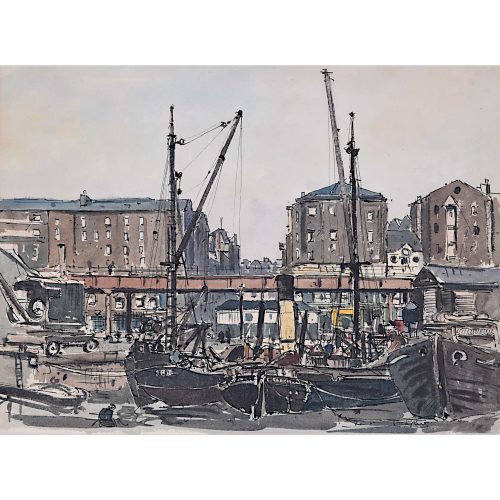
Claude Muncaster (1903-1974) Liverpool Docks
Dated 1928 Inscribed to reverse Watercolour 28x37cm Muncaster's watercolours capture the English countryside feel with great competence and feeling. Here he records the docks at Liverpool, a busy scene with splashes of bright paint enlivening the otherwise dull smoky port. Liverpool Claude Grahame Muncaster, RWS, ROI, RBA, SMA was the son of Oliver Hall RA. At the age of fifteen his career as a landscape painter began, and he soon took to the seas, spending the 1920s and 30s travelling the world with his sketchbook in a series of vessels. With the outbreak of war and he joined the RNVR training as a navigator. Having left school at fifteen his mathematics was very weak and it was a relief for all when his artistic talents meant he was recruited as a camofleur. A master of capturing seascapes he was therefore able to hide huge ships ‘in plain sight’ with clever disguises. After the war he painted for the Royal Family and was a frequent guest at Sandringham. Claude Muncaster was a watercolourist known for his landscapes and maritime scenes. He was born Grahame Hall, the son of the Royal Academician Oliver Hall who taught his son to paint from an early age; Grahame first exhibited his work aged 15 and a few years later was showing at the RA. However, he adopted the name Claude Muncaster in 1922 to dissociate his career from that of his father. Muncaster’s primary choice of subject matter came from a genuine love of the sea. He made several long-distance sea voyages, including one around the Horn as a deckhand in the windjammer Olivebank in 1931, which he described in ‘Rolling Round the Horn’, published in 1933. Armed with a sketchbook, his aim was to be able to ‘paint ships and the sea with greater authority’. This he certainly achieved, perfectly capturing the limpid first light of morning over the Port of Aden, the choppy rain-grey waters of the Bay of Biscay and a streak of sunlight through gathering storm clouds at dusk in Exeter. He became an Associate of the Royal Watercolour Society in 1931 and was a founder member, and later President, of the Royal Society of Marine Artists. During the Second World War, Muncaster served in the Royal Naval Volunteer Reserve (RNVR) from 1940-44, training as a navigator before going on to advise on the camouflage of ships, and also worked as an official war artist. In ‘Still Morning at Aden’ (1944) he depicts Allied warships in this safe anchorage in the Middle East; the back is stamped with Admiralty approval. In 1946-7 he was commissioned by the Queen to produce watercolours of the royal residences at Windsor, Sandringham and Balmoral; the Duke of Edinburgh, in a foreword to a biography of Muncaster, recalls looking at these and considering the artist’s ‘unerring instinct for a subject’, his sense of atmosphere. Other commissions included large panoramas of the Thames and of Bradford. His career also included work as an etcher, illustrator, writer, lecturer and broadcaster, and his paintings can be found in the Royal Academy, Tate, National Maritime Museum Cornwall, National Railway Museum and Royal Air Force Museum. If you are interested email info@manningfineart.co.uk or call us on 07929 749056. Condition: Conservation mounted and wrapped in transparent sleeve for protection; slight toning to extremities and possibly some loss of colour from sky. -
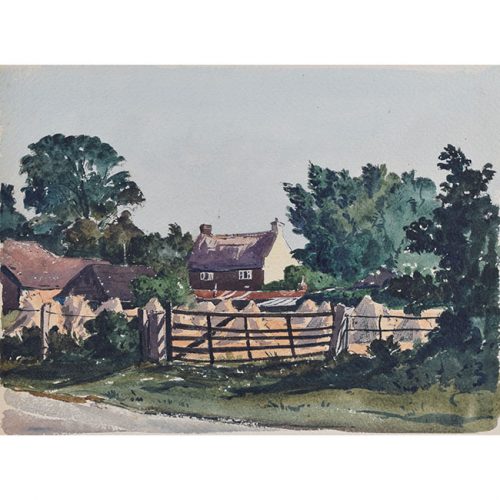
Claude Muncaster
Landscape with Harvest Field and Cottage
Pen and watercolour 22x29cm Provenance: Martin Muncaster, the artist's son. Click here for biographical details and other works by the artist. If you are interested email info@manningfineart.co.uk or call us on 07929 749056. -
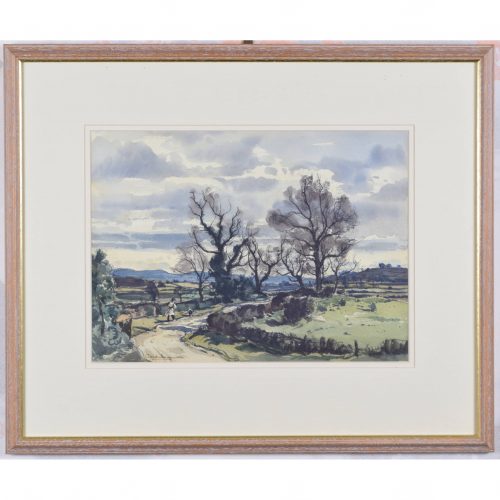
Claude Muncaster Landscape Near Shrewsbury
Watercolour 26 x 36 cm Signed lower left; framed. Click here for biographical details and other works by the artist. If you are interested email info@manningfineart.co.uk or call us on 07929 749056. Condition: Good. -
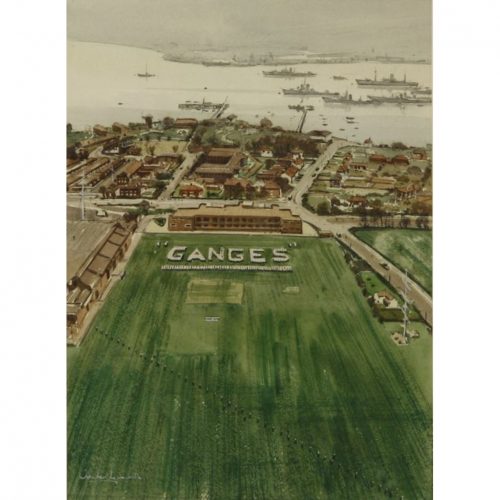
Claude Muncaster (1903-1974)
HMS Ganges near Harwich as seen from a Naval Helicopter
Watercolour with touches of gouache over pencil traces 41x31cm Signed Titled and dated 1956 to reverse HMS Ganges was a shore training establishment of the British Royal Navy. A group of ratings is spelling out the word "Ganges" as a further group are lined across the field. To the right may be seen the artificial mast that cadets learned to climb. In the sea beyond stand warships and other vessels. Muncaster was particularly keen on helicopters for obtaining an alternative view of a scene Click here for biographical details and other works by the artist. If you are interested, email info@manningfineart.co.uk or call us on 07929 749056. -
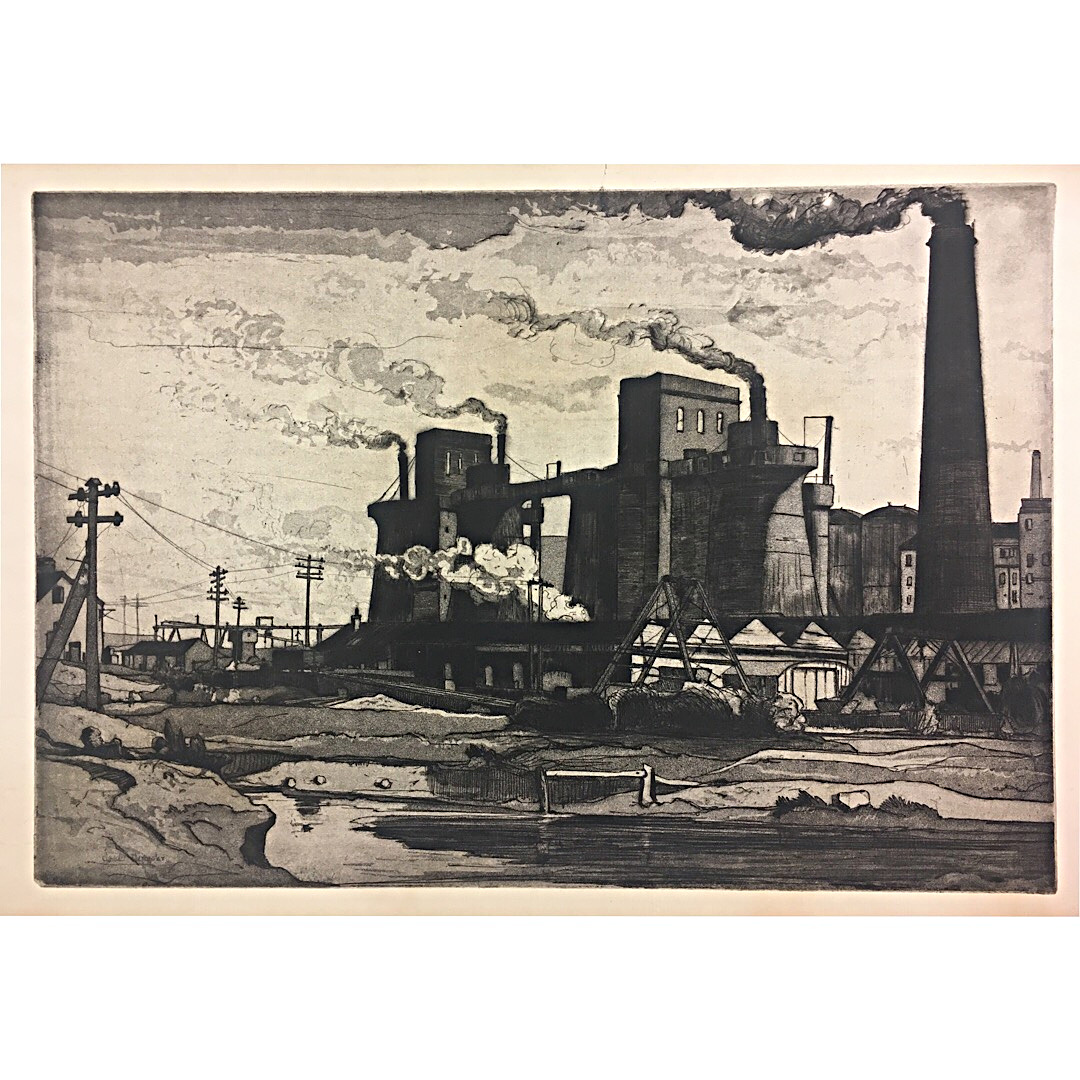
Claude Muncaster (1903-1974) Factory Scene
Monochrome aquatint Signed in plate 22x28cm Provenance: the family of the artist, by descent. Click here for more from the same source. Aquatint is an unusual medium for Muncaster - the renowned watercolourist - and an unusual subject. Here he has handled the factory scene with perhaps more even than his usual skill. The smoke makes dramatic courses across the sky, and the wires, roofs and gantries all bring very strong triangular forms to a scene with powerful vertical lines. Claude Grahame Muncaster, RWS, ROI, RBA, SMA was the son of Oliver Hall RA. At the age of fifteen his career as a landscape painter began, and he soon took to the seas, spending the 1920s and 30s travelling the world with his sketchbook in a series of vessels. With the outbreak of war and he joined the RNVR training as a navigator. Having left school at fifteen his mathematics was very weak and it was a relief for all when his artistic talents meant he was recruited as a camofleur. A master of capturing seascapes he was therefore able to hide huge ships ‘in plain sight’ with clever disguises. After the war he painted for the Royal Family and was a frequent guest at Sandringham. Claude Muncaster was a watercolourist known for his landscapes and maritime scenes. He was born Grahame Hall, the son of the Royal Academician Oliver Hall who taught his son to paint from an early age; Grahame first exhibited his work aged 15 and a few years later was showing at the RA. However, he adopted the name Claude Muncaster in 1922 to dissociate his career from that of his father. Muncaster’s primary choice of subject matter came from a genuine love of the sea. He made several long-distance sea voyages, including one around the Horn as a deckhand in the windjammer Olivebank in 1931, which he described in ‘Rolling Round the Horn’, published in 1933. Armed with a sketchbook, his aim was to be able to ‘paint ships and the sea with greater authority’. This he certainly achieved, perfectly capturing the limpid first light of morning over the Port of Aden, the choppy rain-grey waters of the Bay of Biscay and a streak of sunlight through gathering storm clouds at dusk in Exeter. He became an Associate of the Royal Watercolour Society in 1931 and was a founder member, and later President, of the Royal Society of Marine Artists. During the Second World War, Muncaster served in the Royal Naval Volunteer Reserve (RNVR) from 1940-44, training as a navigator before going on to advise on the camouflage of ships, and also worked as an official war artist. In ‘Still Morning at Aden’ (1944) he depicts Allied warships in this safe anchorage in the Middle East; the back is stamped with Admiralty approval. In 1946-7 he was commissioned by the Queen to produce watercolours of the royal residences at Windsor, Sandringham and Balmoral; the Duke of Edinburgh, in a foreword to a biography of Muncaster, recalls looking at these and considering the artist’s ‘unerring instinct for a subject’, his sense of atmosphere. Other commissions included large panoramas of the Thames and of Bradford. His career also included work as an etcher, illustrator, writer, lecturer and broadcaster, and his paintings can be found in the Royal Academy, Tate, National Maritime Museum Cornwall, National Railway Museum and Royal Air Force Museum. -
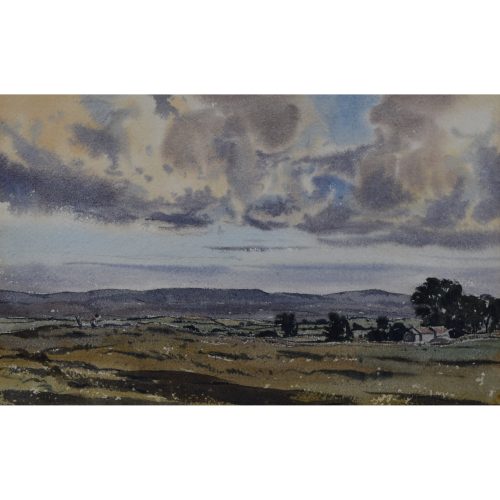
Claude Muncaster (1903-1974)
English Landscape
Pen and watercolour 23x34cm A classic Claude Muncaster. Rolling clouds billow over an English landscape studded with windswept trees, drystone walls, and a farmhouse. Click here for biographical details and other works by the artist. If you'd like to know more, email info@manningfineart.co.uk or call us on 07929 749056. -
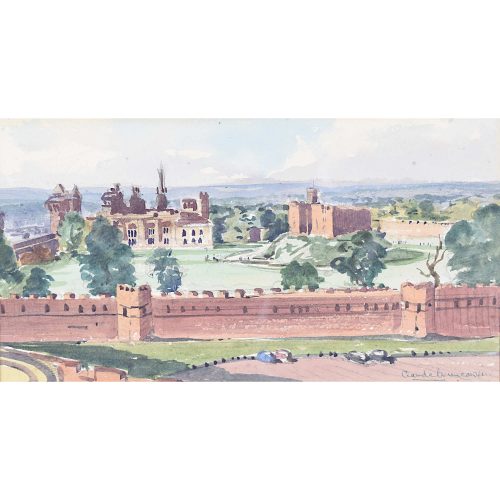
Claude Muncaster (1903-1974) Cardiff Castle Wales
Dated May 1962 Signed lower right Watercolour 14x26cm Muncaster's watercolours capture the British countryside feel with great competence and passion. Here the ancient scheduled monument of Cardiff castle is made to feel both grand and imposing, yet reflecting the softness of the countryside. A few elegant motorcars are parked before it. Claude Grahame Muncaster, RWS, ROI, RBA, SMA was the son of Oliver Hall RA. At the age of fifteen his career as a landscape painter began, and he soon took to the seas, spending the 1920s and 30s travelling the world with his sketchbook in a series of vessels. With the outbreak of war and he joined the RNVR training as a navigator. Having left school at fifteen his mathematics was very weak and it was a relief for all when his artistic talents meant he was recruited as a camofleur. A master of capturing seascapes he was therefore able to hide huge ships ‘in plain sight’ with clever disguises. After the war he painted for the Royal Family and was a frequent guest at Sandringham. Claude Muncaster was a watercolourist known for his landscapes and maritime scenes. He was born Grahame Hall, the son of the Royal Academician Oliver Hall who taught his son to paint from an early age; Grahame first exhibited his work aged 15 and a few years later was showing at the RA. However, he adopted the name Claude Muncaster in 1922 to dissociate his career from that of his father. Muncaster’s primary choice of subject matter came from a genuine love of the sea. He made several long-distance sea voyages, including one around the Horn as a deckhand in the windjammer Olivebank in 1931, which he described in ‘Rolling Round the Horn’, published in 1933. Armed with a sketchbook, his aim was to be able to ‘paint ships and the sea with greater authority’. This he certainly achieved, perfectly capturing the limpid first light of morning over the Port of Aden, the choppy rain-grey waters of the Bay of Biscay and a streak of sunlight through gathering storm clouds at dusk in Exeter. He became an Associate of the Royal Watercolour Society in 1931 and was a founder member, and later President, of the Royal Society of Marine Artists. During the Second World War, Muncaster served in the Royal Naval Volunteer Reserve (RNVR) from 1940-44, training as a navigator before going on to advise on the camouflage of ships, and also worked as an official war artist. In ‘Still Morning at Aden’ (1944) he depicts Allied warships in this safe anchorage in the Middle East; the back is stamped with Admiralty approval. In 1946-7 he was commissioned by the Queen to produce watercolours of the royal residences at Windsor, Sandringham and Balmoral; the Duke of Edinburgh, in a foreword to a biography of Muncaster, recalls looking at these and considering the artist’s ‘unerring instinct for a subject’, his sense of atmosphere. Other commissions included large panoramas of the Thames and of Bradford. His career also included work as an etcher, illustrator, writer, lecturer and broadcaster, and his paintings can be found in the Royal Academy, Tate, National Maritime Museum Cornwall, National Railway Museum and Royal Air Force Museum. If you are interested email info@manningfineart.co.uk or call us on 07929 749056. Conditon: Conservation mounted and wrapped in transparent sleeve for protection. Generally good condition. -
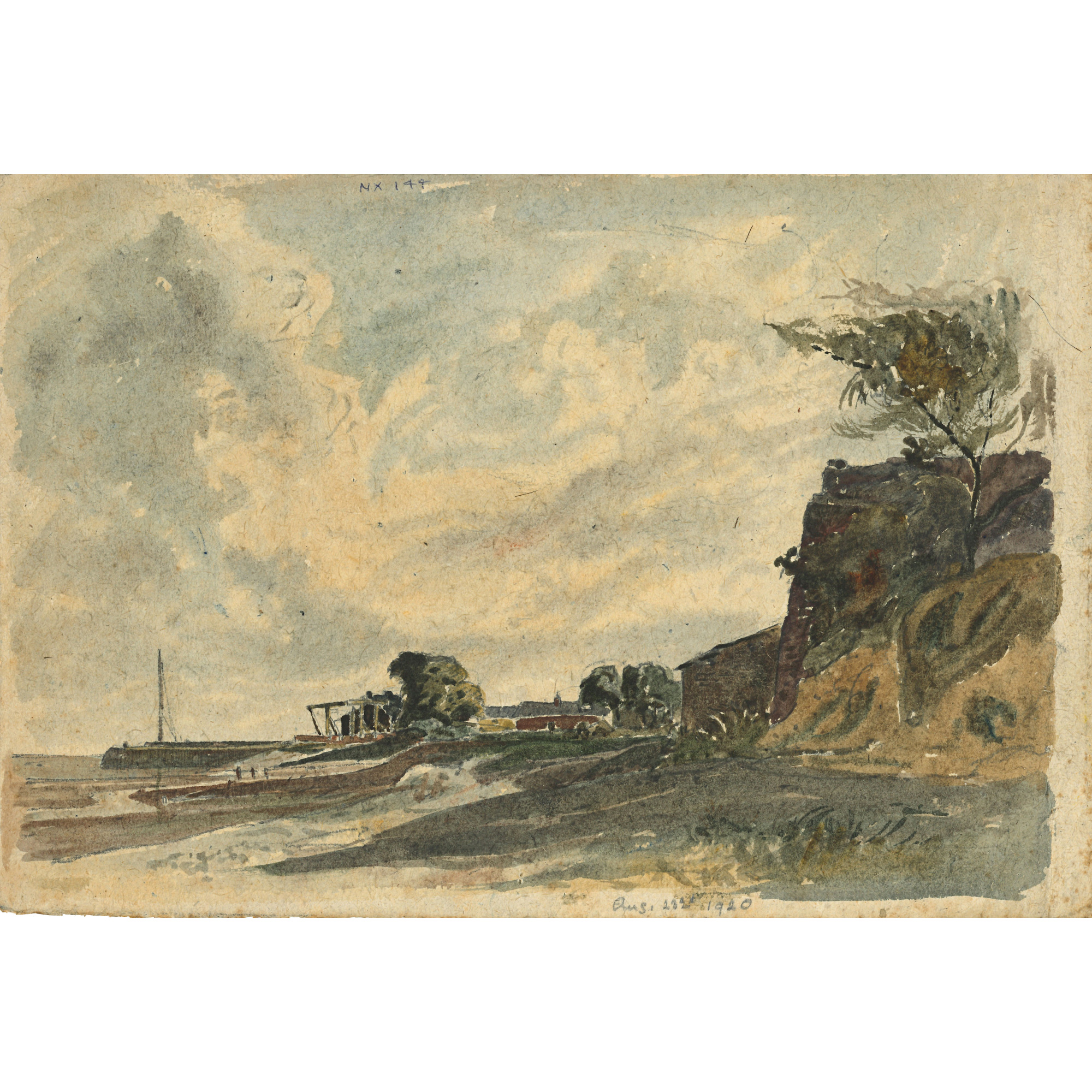
Claude Muncaster (1903-1974)
Canal Foot Ulverston Canal
Signed and titled to reverse Inscribed Aug. 23rd (?) 1920 Pen and watercolour 19x29cm Muncaster's watercolours capture the English countryside feel with great competence. Here he records the old swing bridge across the lock at the foot of the now-derelict Ulverston Canal. It was Britain's straightest canal, running two miles from Morecambe Bay to Ulverston but has long stood unused. Click here for biographical details and other works by the artist. If you are interested email info@manningfineart.co.uk or call us on 07929 749056. -
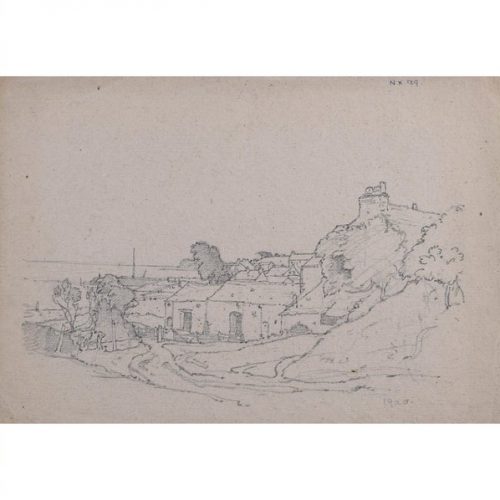
Claude Muncaster (1903-1974) Canal Foot, The Ulverston Canal
1920 Inscribed to reverse and numbered NX129 in the artist's catalogue Pencil Sketch 21x30cm Provenance: The estate of the artist and by descent Muncaster's watercolours capture the English countryside feel with great competence. Here he records the old swing bridge across the lock at the foot of the now-derelict Ulverston Canal. It was Britain's straightest canal, running two miles from Morecambe Bay to Ulverston but has long stood unused. Oliver Hall, Muncaster's father, lived at Ulverston in his latter years. Claude Grahame Muncaster, RWS, ROI, RBA, SMA was the son of Oliver Hall RA. At the age of fifteen his career as a landscape painter began, and he soon took to the seas, spending the 1920s and 30s travelling the world with his sketchbook in a series of vessels. With the outbreak of war and he joined the RNVR training as a navigator. Having left school at fifteen his mathematics was very weak and it was a relief for all when his artistic talents meant he was recruited as a camofleur. A master of capturing seascapes he was therefore able to hide huge ships ‘in plain sight’ with clever disguises. After the war he painted for the Royal Family and was a frequent guest at Sandringham. Claude Muncaster was a watercolourist known for his landscapes and maritime scenes. He was born Grahame Hall, the son of the Royal Academician Oliver Hall who taught his son to paint from an early age; Grahame first exhibited his work aged 15 and a few years later was showing at the RA. However, he adopted the name Claude Muncaster in 1922 to dissociate his career from that of his father. Muncaster’s primary choice of subject matter came from a genuine love of the sea. He made several long-distance sea voyages, including one around the Horn as a deckhand in the windjammer Olivebank in 1931, which he described in ‘Rolling Round the Horn’, published in 1933. Armed with a sketchbook, his aim was to be able to ‘paint ships and the sea with greater authority’. This he certainly achieved, perfectly capturing the limpid first light of morning over the Port of Aden, the choppy rain-grey waters of the Bay of Biscay and a streak of sunlight through gathering storm clouds at dusk in Exeter. He became an Associate of the Royal Watercolour Society in 1931 and was a founder member, and later President, of the Royal Society of Marine Artists. During the Second World War, Muncaster served in the Royal Naval Volunteer Reserve (RNVR) from 1940-44, training as a navigator before going on to advise on the camouflage of ships, and also worked as an official war artist. In ‘Still Morning at Aden’ (1944) he depicts Allied warships in this safe anchorage in the Middle East; the back is stamped with Admiralty approval. In 1946-7 he was commissioned by the Queen to produce watercolours of the royal residences at Windsor, Sandringham and Balmoral; the Duke of Edinburgh, in a foreword to a biography of Muncaster, recalls looking at these and considering the artist’s ‘unerring instinct for a subject’, his sense of atmosphere. Other commissions included large panoramas of the Thames and of Bradford. His career also included work as an etcher, illustrator, writer, lecturer and broadcaster, and his paintings can be found in the Royal Academy, Tate, National Maritime Museum Cornwall, National Railway Museum and Royal Air Force Museum. If you are interested email info@manningfineart.co.uk or call us on 07929 749056. Condition: Good. Conservation mounted and wrapped in transparent sleeve for protection -
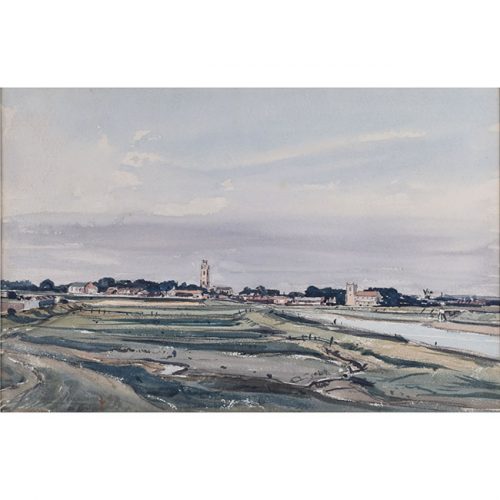
Claude Muncaster (1903-1974)
Boston Stump
Signed Pen and watercolour 23x34cm (Titled erroneously to reverse 'North Norfolk Churches' Click here for biographical details and other works by the artist. If you are interested email info@manningfineart.co.uk or call us on 07929 749056. -
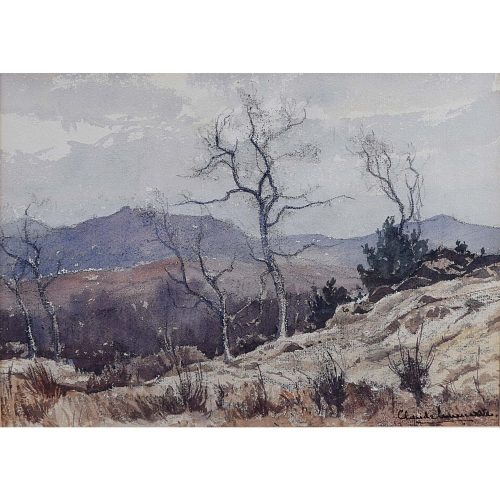
Claude Muncaster Above Finsthwaite, near Newby Bridge 1968
Watercolour 21x26.5cm 46x52cm including frame, UK shipping only Signed lower right Click here for biographical details and other works by the artist. If you are interested email info@manningfineart.co.uk or call us on 07929 749056. Condition: Good. -
Sale!
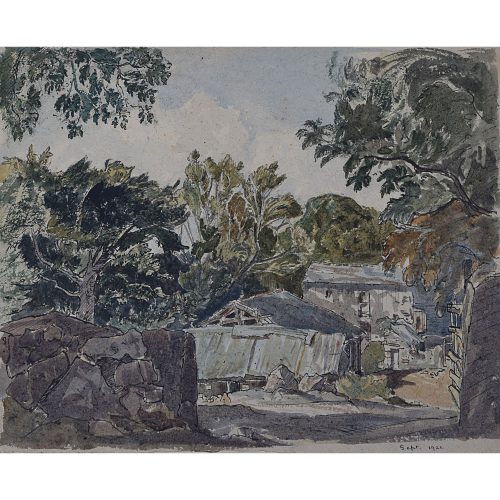
Claude Muncaster (1903-1974) Farmstead and Trees
Dated Sept 1921 Signed on reverse with additional sketches of figures Watercolour 22x28cm Claude Grahame Muncaster, RWS, ROI, RBA, SMA was the son of Oliver Hall RA. At the age of fifteen his career as a landscape painter began, and he soon took to the seas, spending the 1920s and 30s travelling the world with his sketchbook in a series of vessels. With the outbreak of war and he joined the RNVR training as a navigator. Having left school at fifteen his mathematics was very weak and it was a relief for all when his artistic talents meant he was recruited as a camofleur. A master of capturing seascapes he was therefore able to hide huge ships ‘in plain sight’ with clever disguises. After the war he painted for the Royal Family and was a frequent guest at Sandringham. Claude Muncaster was a watercolourist known for his landscapes and maritime scenes. He was born Grahame Hall, the son of the Royal Academician Oliver Hall who taught his son to paint from an early age; Grahame first exhibited his work aged 15 and a few years later was showing at the RA. However, he adopted the name Claude Muncaster in 1922 to dissociate his career from that of his father. Muncaster’s primary choice of subject matter came from a genuine love of the sea. He made several long-distance sea voyages, including one around the Horn as a deckhand in the windjammer Olivebank in 1931, which he described in ‘Rolling Round the Horn’, published in 1933. Armed with a sketchbook, his aim was to be able to ‘paint ships and the sea with greater authority’. This he certainly achieved, perfectly capturing the limpid first light of morning over the Port of Aden, the choppy rain-grey waters of the Bay of Biscay and a streak of sunlight through gathering storm clouds at dusk in Exeter. He became an Associate of the Royal Watercolour Society in 1931 and was a founder member, and later President, of the Royal Society of Marine Artists. During the Second World War, Muncaster served in the Royal Naval Volunteer Reserve (RNVR) from 1940-44, training as a navigator before going on to advise on the camouflage of ships, and also worked as an official war artist. In ‘Still Morning at Aden’ (1944) he depicts Allied warships in this safe anchorage in the Middle East; the back is stamped with Admiralty approval. In 1946-7 he was commissioned by the Queen to produce watercolours of the royal residences at Windsor, Sandringham and Balmoral; the Duke of Edinburgh, in a foreword to a biography of Muncaster, recalls looking at these and considering the artist’s ‘unerring instinct for a subject’, his sense of atmosphere. Other commissions included large panoramas of the Thames and of Bradford. His career also included work as an etcher, illustrator, writer, lecturer and broadcaster, and his paintings can be found in the Royal Academy, Tate, National Maritime Museum Cornwall, National Railway Museum and Royal Air Force Museum. Condition: generally good, few isolated spots to sky as can be seen in the magnified version of the picture. If you are interested email info@manningfineart.co.uk or call us on 07929 749056. -
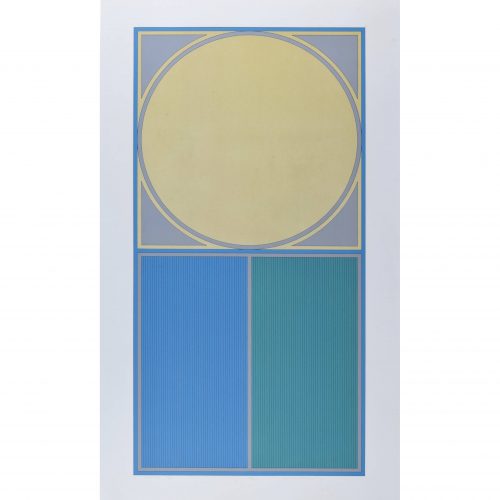
Gordon House (1932 - 2004)
Circle E
Lithograph 86 x 45 cm Signed, numbered 48/75, and titled in pencil below the plate. An excellent example of Gordon House's work: a modern design, influenced by art deco, in blue and yellow. Gordon House was born in Pontardawe, South Wales in 1932 and studied at Luton and St. Albans Schools of Art. He began working for advertising agencies in the 1950s and became a full-time artist in 1961, exhibiting several solo shoes. He designed for several leading London galleries, the Ashmolean Museum in Oxford, and popular bands such as the Beatles and the Rolling Stones. Several dozen Gordon House prints are held by the Tate. Condition: very good; backed to board. If you are interested, please email info@manningfineart.co.uk or call us on 07929 749056. Click here for other abstract lithographs by Gordon House. -
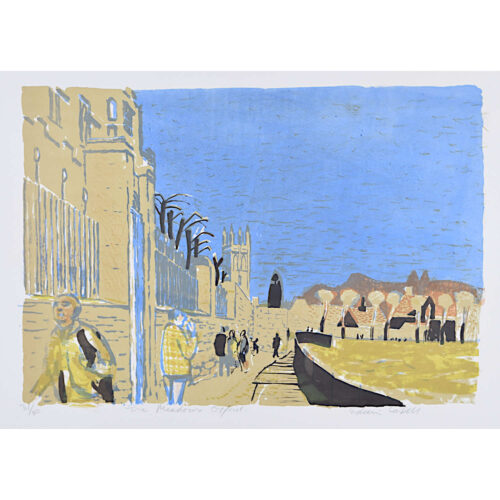
Edwin La Dell (1914-1970)
The Meadows, Oxford
Lithograph 40 x 55 cm Signed, titled, and numbered 31/80 in pencil. A bright blue winter sky looks over Christ Church Meadows, complete with pedestrians waltzing down Deadman's Walk. La Dell studied at the Sheffield School of Art, where he won a scholarship to the Royal College of Art. From 1934 to 1940 John Nash was the head of printmaking there, and taught La Dell. La Dell himself became head of lithography there in 1948, and remained in post until his death. During the war La Dell was an official war artist and a camofleur, but he is probably best known for his lithographs of Oxford and Cambridge that he published himself. His works are widely held in the public collections, including the Royal Academy and the Government Art Collection, the latter of which holds many of his views of Cambridge. Condition: very good. Backed to linen. If you are interested, please email info@manningfineart.co.uk or call us on 07929 749056. Click here for other views of Christ Church. -
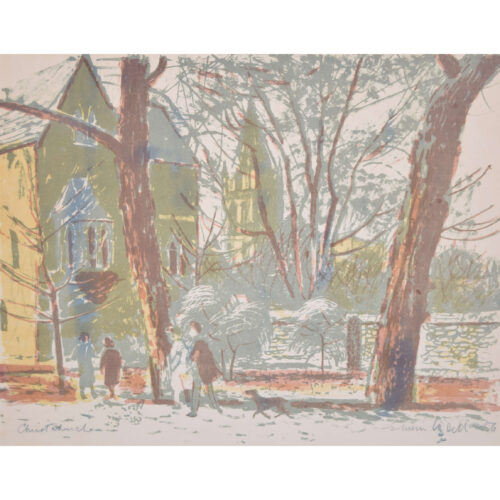
Edwin La Dell (1914-1970)
Christ Church, Oxford (1956)
Lithograph 33 x 42 cm Signed and dated lower right. With invoice from Royal Academy and letter from the artist. This view of Christ Church from the meadows is rendered in a muted palette, suggestive of a late autumn afternoon. Four coat-and-hat-clad pedestrians stroll along, accompanied by small child and dog. La Dell studied at the Sheffield School of Art, where he won a scholarship to the Royal College of Art. From 1934 to 1940 John Nash was the head of printmaking there, and taught La Dell. La Dell himself became head of lithography there in 1948, and remained in post until his death. During the war La Dell was an official war artist and a camofleur, but he is probably best known for his lithographs of Oxford and Cambridge that he published himself. His works are widely held in the public collections, including the Royal Academy and the Government Art Collection, the latter of which holds many of his views of Cambridge. Condition: mounted to board. Slight but even age toning. If you are interested, please email info@manningfineart.co.uk or call us on 07929 749056. Click here for other views of Christ Church. -
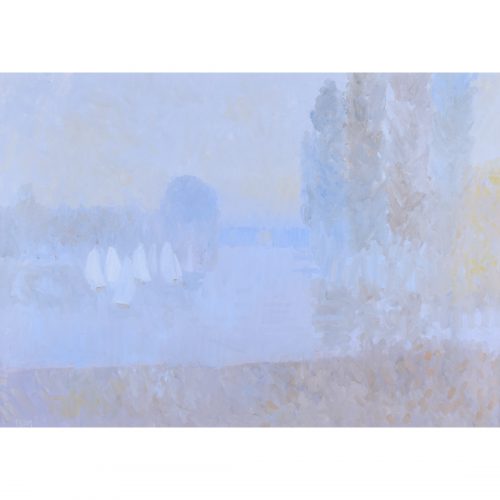
Bernard Myers (1925 - 2007)
Chiswick Reach
Oil on paper 50 x 72 cm Myers' impressionist view of Chiswick Reach (likely painted from his studio, which overlooked the Thames) depicts a hazy morning mist making its way down the river. The artist's sparse and muted palette renders the sky barely discernible from the water; chevron brushstrokes make up trees which cast their shadows over the Thames. A flotilla of boats, ghost-like with their white sails, appear from the blue mist. Bernard Myers was a painter and printmaker who trained at St Martin’s School of Art, the Camberwell School of Arts and Crafts, and the Royal College of Art in the 1940s and 1950s. This painting won the David Murray Landscape Scholarship and was painted while Myers was a student at the RCA. He went on to teach there before moving into a studio in Hammersmith. He lived and painted at 5 Durham Wharf, just off Chiswick Mall and with a view of the Thames, from the 1980s until his death in 2007. Provenance: New Grafton Gallery. Condition: excellent. If you are interested, please email info@manningfineart.co.uk or call us on 07929 749056. Click here for other views of London. -
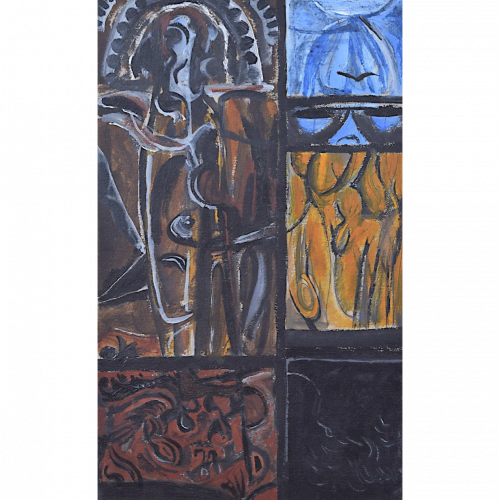
Charles Pulsford ARSA (1912-1989)
Abstract Stained Glass Design
Gouache 40 x 25 cm Provenance: the artist, the residual stock of William Hardie Gallery. This mesmerising depiction of an abstract figure is likely a design for a stained glass window panel. Pulsford was born in Staffordshire to Scottish parents. His family returned to Dunfermline when he was a child, and he subsequently attended Edinburgh College of Art (ECA) between 1933 and 1937. He, along with other prominent Scottish artists, embraced modernism and abstraction following the end of the war. Alan Davie, William Turnbull, William Gear and Eduardo Paolozzi are the key artists of the group with which he was association, and the National Galleries of Scotland regard Pulsford as the 'fifth man' of the group. Between 1952 and 1960 he taught at ECA and then at Canterbury College of Art. Condition: Generally very good. If you are interested, email info@manningfineart.co.uk or call us on 07929 749056. -
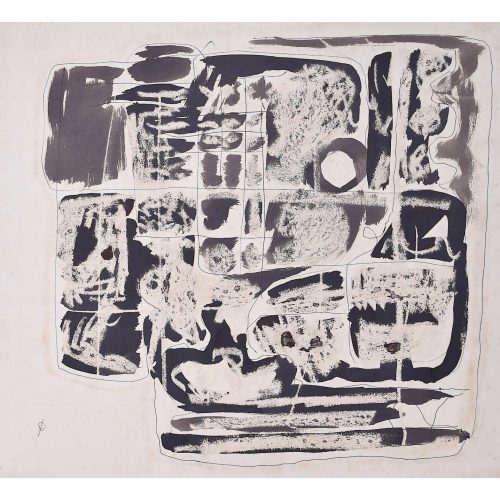
Charles Pulsford ARSA (1912-1989)
'Monochrome Landscape'
Watercolour with ink 39 x 43 cm Initialled lower left Provenance: the artist; the residual stock of William Hardie. Pulsford was born in Staffordshire to Scottish parents. His family returned to Dunfermline when he was a child, and he subsequently attended Edinburgh College of Art (ECA) between 1933 and 1937. He, along with other prominent Scottish artists, embraced modernism and abstraction following the end of the war. Alan Davie, William Turnbull, William Gear and Eduardo Paolozzi are the key artists of the group with which he was association, and the National Galleries of Scotland regard Pulsford as the 'fifth man' of the group. Between 1952 and 1960 he taught at ECA and then at Canterbury College of Art. Condition: Good. Paper slightly toned, a little spotting. If you are interested, please email info@manningfineart.co.uk or call us on 07929 749056. -
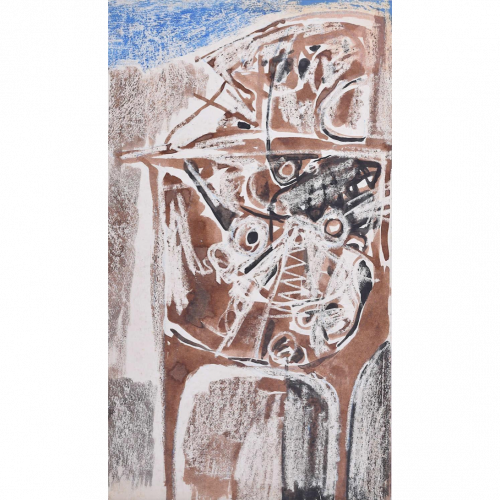
Charles Pulsford ARSA (1912-1989)
Abstract Landscape
Watercolour with wax resist 55 x 31 cm Provenance: the artist; the residual stock of William Hardie. Pulsford was born in Staffordshire to Scottish parents. His family returned to Dunfermline when he was a child, and he subsequently attended Edinburgh College of Art (ECA) between 1933 and 1937. He, along with other prominent Scottish artists, embraced modernism and abstraction following the end of the war. Alan Davie, William Turnbull, William Gear and Eduardo Paolozzi are the key artists of the group with which he was association, and the National Galleries of Scotland regard Pulsford as the 'fifth man' of the group. Between 1952 and 1960 he taught at ECA and then at Canterbury College of Art. Condition: Generally very good. If you are interested, please email info@manningfineart.co.uk or call us on 07929 749056. -
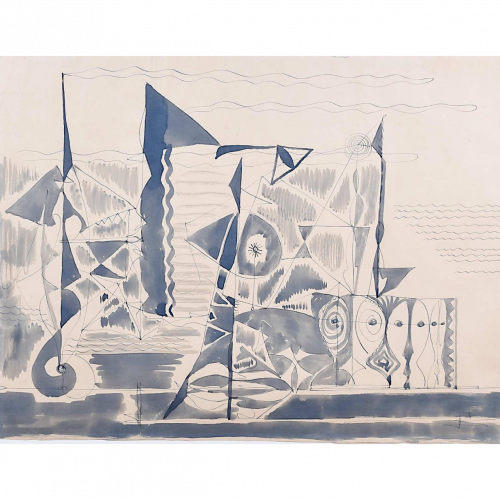
Charles Pulsford ARSA (1912-1989)
Abstract Harbour
Watercolour 36 x 46 cm Signed lower right. Pulsford was born in Staffordshire to Scottish parents. His family returned to Dunfermline when he was a child, and he subsequently attended Edinburgh College of Art (ECA) between 1933 and 1937. He, along with other prominent Scottish artists, embraced modernism and abstraction following the end of the war. Alan Davie, William Turnbull, William Gear and Eduardo Paolozzi are the key artists of the group with which he was association, and the National Galleries of Scotland regard Pulsford as the 'fifth man' of the group. Between 1952 and 1960 he taught at ECA and then at Canterbury College of Art. Provenance: the artist, the residual stock of William Hardie Gallery. Condition: Generally very good, in fine hand-finished frame. If you are interested, email info@manningfineart.co.uk or call us on 07929 749056. -
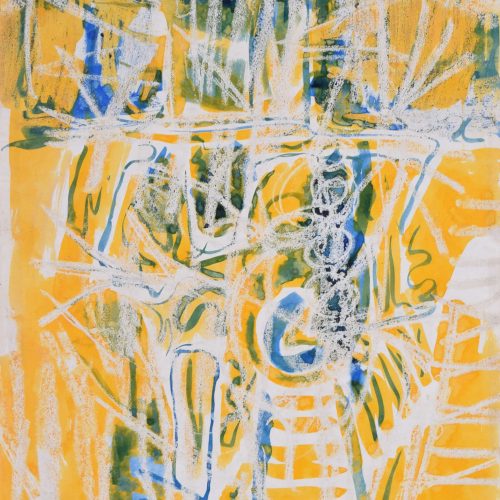
Charles Pulsford ARSA (1912 - 1989)
Abstract Figure in Yellow and Blue
Watercolour and ink 56 x 38 cm Signed lower right. An abstract figure in arresting colours. The artist plays with the intersection of round and lateral mark-making to form a human figure, perhaps reminiscent of a crucifixion. Pulsford's skill as an abstract landscape artist is also evident here, with the form suggestive of natural and industrial topography like fields, rivers, railway tracks, and electric pylons. Pulsford was born in Staffordshire to Scottish parents. His family returned to Dunfermline when he was a child, and he subsequently attended Edinburgh College of Art (ECA) between 1933 and 1937. He, along with other prominent Scottish artists, embraced modernism and abstraction following the end of the war. Alan Davie, William Turnbull, William Gear and Eduardo Paolozzi are the key artists of the group with which he was association, and the National Galleries of Scotland regard Pulsford as the 'fifth man' of the group. Between 1952 and 1960 he taught at ECA and then at Canterbury College of Art. Condition: generally very good, old tape stains to extreme margins. If you are interested email info@manningfineart.co.uk or call us on 07929 749056. Provenance: the artist, the residual stock of William Hardie. -
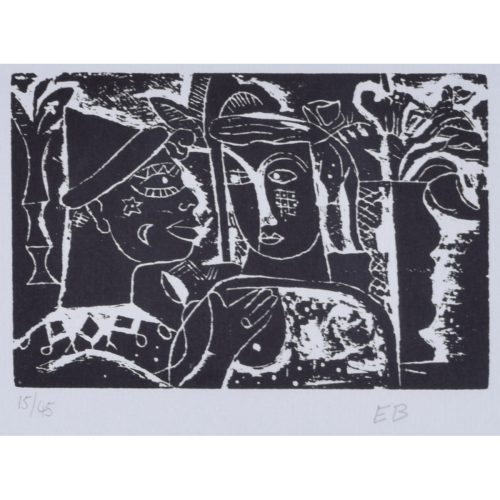
Edward Burra (1905 - 1976)
Café
(1928 - 1929, this edition published 1971) Woodcut 10 x 15 cm; sheet size 24 x 34 cm Numbered 15/45 lower left and initialled EB lower right. Published by the Nicholas Treadwell Gallery in 1971. Burra's woodcut of a male and a female figure, entitled 'Café'. The two figures, seemingly a couple, gaze at one another intensely and intimately, giving the impression of having been interrupted by the viewer. Both figures' faces bear tattoo-like markings: he a star and the moon, she a geometric design resembling a noughts-and-crosses board. The "café" in which they sit is a dreamily abstract landscape full of palms and other plants from the tropics. Edward Burra was an English painter, draughtsman, and printmaker. He travelled to Italy in 1925, the same year he met the noted British Surrealist Paul Nash, and both of these influences are evident in this woodcut. Nash introduced Burra to woodcut-making in 1928, the same year that Burra began this woodcut series. His first solo show was held at the Leicester Galleries in April 1929, and he exhibited with the English Surrealists in the 1930s. Condition: Excellent. If you’d like to know more, please email info@manningfineart.co.uk or call us on 07929 749056. -
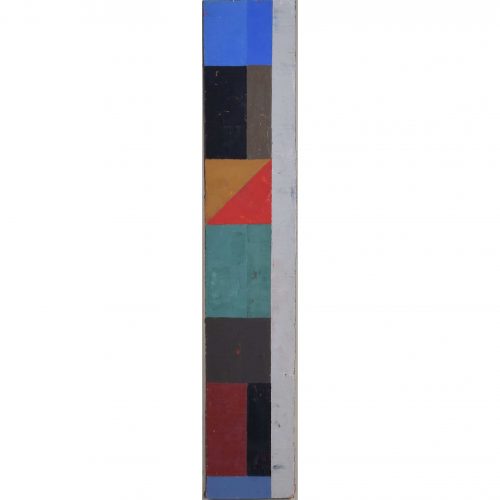
Bryan Ingham (1936-1997)
Erotische Bild (1988)
Oil on board 62 x 11 cm Provenance: Fracis Graham-Dixon gallery. Titled to backboard and dated 1988. Bryan Ingham was born in Yorkshire. For his National Service he joined the RAF, and spent his time in Germany as an airman. After demobilisation, his final report included the statement that "Ingham is an artistic sort of airman." In his spare time he had started painting in oils, and by the time he left the RAF he had completed a large number of paintings. He studied at St Martin's School of Art in London, where he had the tuition of a fine post-war generation of teachers who helped him to hone his draughtsmanship and other skills, and he swiftly showed a capacity for painting that drew the attention of his tutors and peers. On graduating he was offered and accepted a post-graduate place at the Royal College of Art, where in his second year he was awarded a Royal Scholarship and was a contemporary of a number of now better-known names including David Hockney. Ingham applied for and received a Leverhulme travel award to explore the sites of the great Renaissance painters, and spent many happy months engaged in this expedition. He spent time at the English Art school in Rome, where he lived well and busied himself the same studio that Barbara Hepworth had used. At this stage of his career, Ingham consciously rejected the prospect of pursuing a career as an establishment artist, although the RA was open to him, and he went to live in remote cottage in Cornwall. The subsequent years were varied and highly productive, and Ingham's personal artistic voice emerged in his oeuvre in the form of an always-developing dialogue with influences both of landscape and other artists of every age. His preoccupation with etching resulted in several hundred plates, some very large, and the results are as unmistakable as they are varied, but invariably of outstanding quality. He produced a number of sculptures in bronze and in plaster, while his lifelong output of paintings remained small but again of very high quality. He taught etching regularly until about 5 years before his death, latterly at Falmouth Art School, and also at Farnham Art College. During the late eighties he established a relationship with the art dealer Francis Graham-Dixon, who had a London gallery. This meant that his paintings were professionally marketed for the first time, and prices for his work rose steadily in the last ten years of his life, and subsequently. He was able to purchase a cottage in Helston for his parents, who lived there until their deaths. He then moved into a fine set of converted-barn studios with a patch of garden, quietly situated off the High St in Helston, and it was here, on 22 September 1997, that he died, having quietly suffered from cancer for nearly a year. Condition: Generally very good, scrapes to board as intended by artist. Framed. If you'd like to know more, please email info@manningfineart.co.uk or call us on 07929 749056. -

Bryan Ingham (1936-1997)
Upright Jug (1993-95)
Pencil and oil on board 64 x 19 cm Provenance: Bohun Galleries, Paintings in Hospitals. Signed, titled and dated 1993-95 (on backboard). Bryan Ingham was born in Yorkshire. For his National Service he joined the RAF, and spent his time in Germany as an airman. After demobilisation, his final report included the statement that "Ingham is an artistic sort of airman." In his spare time he had started painting in oils, and by the time he left the RAF he had completed a large number of paintings. He studied at St Martin's School of Art in London, where he had the tuition of a fine post-war generation of teachers who helped him to hone his draughtsmanship and other skills, and he swiftly showed a capacity for painting that drew the attention of his tutors and peers. On graduating he was offered and accepted a post-graduate place at the Royal College of Art, where in his second year he was awarded a Royal Scholarship and was a contemporary of a number of now better-known names including David Hockney. Ingham applied for and received a Leverhulme travel award to explore the sites of the great Renaissance painters, and spent many happy months engaged in this expedition. He spent time at the English Art school in Rome, where he lived well and busied himself the same studio that Barbara Hepworth had used. At this stage of his career, Ingham consciously rejected the prospect of pursuing a career as an establishment artist, although the RA was open to him, and he went to live in remote cottage in Cornwall. The subsequent years were varied and highly productive, and Ingham's personal artistic voice emerged in his oeuvre in the form of an always-developing dialogue with influences both of landscape and other artists of every age. His preoccupation with etching resulted in several hundred plates, some very large, and the results are as unmistakable as they are varied, but invariably of outstanding quality. He produced a number of sculptures in bronze and in plaster, while his lifelong output of paintings remained small but again of very high quality. He taught etching regularly until about 5 years before his death, latterly at Falmouth Art School, and also at Farnham Art College. During the late eighties he established a relationship with the art dealer Francis Graham-Dixon, who had a London gallery. This meant that his paintings were professionally marketed for the first time, and prices for his work rose steadily in the last ten years of his life, and subsequently. He was able to purchase a cottage in Helston for his parents, who lived there until their deaths. He then moved into a fine set of converted-barn studios with a patch of garden, quietly situated off the High St in Helston, and it was here, on 22 September 1997, that he died, having quietly suffered from cancer for nearly a year. If you'd like to know more, please email info@manningfineart.co.uk or call us on 07929 749056. Condition: Generally excellent; framed. -

Brendan Neiland (b.1941)
Original Designs for Intercity Posters - Edinburgh and York
Collage, spraypaint and cut out 91x58cm (36×23 inches) each 1991 Click here for biographical details and other works by the artist. If you are interested email info@manningfineart.co.uk or call us on 07929 749056. -
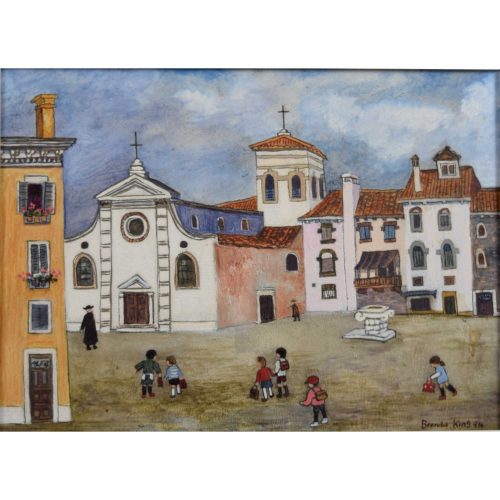
Brenda King (1934-2011)
Venetian Schoolchildren (1974)
Oil on board 16.5.x 20.5 cm Signed and dated lower right. Naive scene of school children in a Venetian square in a distinctive 1970s frame. Brenda King was born in Cumbria in 1934. She enrolled at the Lancaster College of Art from 1950 to 1954 before enrolling at the Royal Academy from 1954 to 1957, indeed, going on to exhibit frequently at the RA summer exhibition. She moved to Cornwall in 1975 with her landscape painter husband Jeremy King (b.1933), and the pair shared a studio in St Just, Lands End. Her distinctively naive and playful style, often capturing incidental figures in quaint, pastoral British scenes, is said to have been strongly influenced by the oils and watercolours of Helen Bradley (1900-1979), another Lancastrian. If you are interested e-mail info@manningfineart.co.uk or call us on 07929 749056 Condition: Generally excellent, original 1970s frame shows some wear. -
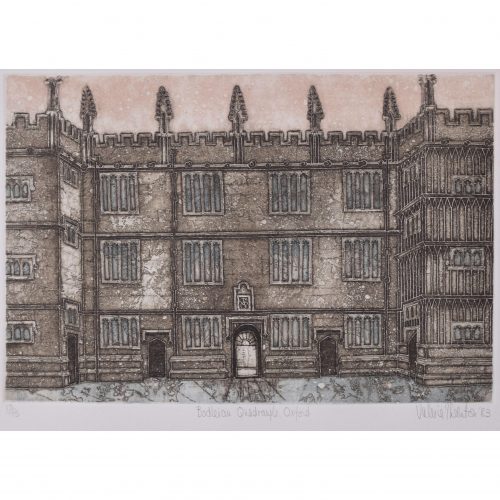
Valerie Thornton (1931-1991)
Bodleian Quadrangle, Oxford (1983)
Etching 24 x 35 cm Numbered 13/75 lower left, titled below, and signed and dated lower right, all in pencil. A very good example of Thornton's recognisable and unusual etching style. Her work is deeply concerned with material, and many of her etchings focus on eroded stone, emotive landscapes, and weathered architecture. Here, Thornton draws out the exceptional texture of the Bodleian Library's local stone. Valerie Thornton was a British etcher and printmaker. She was born in London, but was evacuated to Canada with her two brothers during World War II. She returned to London in 1944 and studied at the Byam Shaw School of Art in 1949. From 1950 to 1953 Thornton studied under P.F. Millard at the Regent Street Polytechnic, then spent eight months at Atelier 17 in Paris. In the early 1960s, she moved to New York and worked at Pratt Graphic Art Centre. In 1955, she succeeded Howard Hodgkin as assistant art teacher at Charterhouse School and in 1965 she became a founding member of the Print Makers Council. In 1970 she became a Fellow of the Royal Society of Painters-Etchers and Engravers. Thornton was a member of The Regent Street Group (a group of nine artists who studied together at the Regent Street Polytechnic in the early 1950s). The group also included Susan Horsfield, Renate Meyer, Michael Lewis, Ken Symonds, Philip Le Bas, and Peter Riches. Thornton's work is included in a number of major public collections including the Victoria and Albert Museum, the British Museum, and the Tate. Thornton died in 1991 in Chelsworth, Suffolk. Condition: generally very good. If you are interested, please email info@manningfineart.co.uk or call us on 07929 749056. Click here for more works by Valerie Thornton. -

Blair Hughes-Stanton (1902-1981) Reclining Nude, c. 1936
Tempera on canvas 76.5 x 102cm Signed lower right 'Blair H S'. Provenance: The estate of the artist. A magnificent abstract nude rendered in a dynamic colour palette. This is probably Hughes-Stanton's most important work, and belongs to the nation's great, if brief, period of British Surrealism. The three major elements are distinct: the pastel tones of the window view and wall, the sensual curvatures of the pale nude, and the bold foreground featuring a fantastically accomplished still life of a fruit bowl (which could be a painting in and of itself) and the impressively phallic chair back. This is a brilliant example of erotic modernist abstraction. Blair Hughes-Stanton, son of the artist Sir Herbert Hughes-Stanton, was a noted British artist of the interwar period. At the age of 13 he joined the Royal Navy training ship HMS Coway, but at 19 - advised by his father - he abandoned the sea for his paintbox. He studied art at Byam Shaw School (1919-1922) where he was influenced by Leon Underwood (who was a major influence throughout his studying), Royal Academy Schools (1922-23), and Leon Underwood's School (1923-25). He was celebrated mostly for his skills as an engraver, and was a founding member of the English Wood Engraving Society when it was established in 1925. His first wife was the printmaker Gertrude Hermes with whom he illustrated John Bunyan's The Pilgrim's Progress in 1928. In 1931 he became head of the Gregynog Press, later establishing the Gemini Press with his second wife Ida Graves. During the course of his career he worked in various media, though his art frequently focused on the female nude. He taught at Westminster School of Art (1934-39), Colchester School of Art (1945-47); St Martin's School of Art (1947-48); and Central School of Arts and Crafts (1948-80). His teaching career was interrupted by the Second World War, during which he served as a camofleur and then joined the Royal Engineers (ignoring his earlier life in the Navy). Serving in Greece, he was captured as a prisoner of war and was imprisoned in a camp. He returned to England after the war. If you’d like to know more, please email info@manningfineart.co.uk or call us on 07929 749056. -
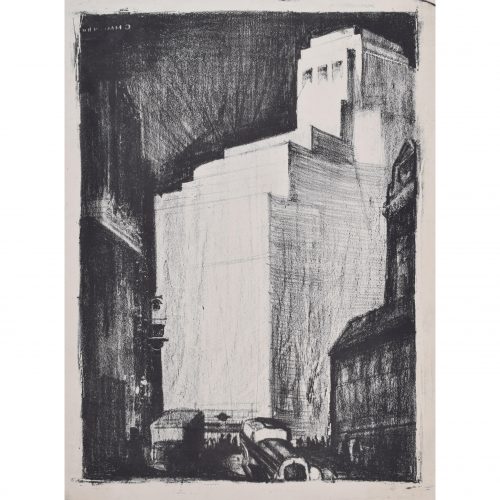
Gerald Mac Spink (flourished 1920 - 1940)
Art Deco City Scene with Engine Car
Block print 41 x 29 cm Signed 'G Mac Spink' in plate (in reverse) upper left. "Over the great bridge, with the sunlight through the girders making a constant flicker upon the moving cars, with the city rising up across the river in white heaps..." - F Scott Fitzgerald, The Great Gatsby An Art Deco city with 1920s engine-cars in the foreground. A white tower-block rises up, emerging palely from a chiaroscuro darkness, a great edifice above the tiny pedestrians below. Spink was a skilled artist, illustrator, and designer who produced a series of posters in the inter-war period for companies including the London Underground, Southern Railways, LNER, Hawker Engineering, and British Steel. He won a prize in 1933 from the Imperial Institute for his poster artwork. He also worked as an aeronautical engineer in Kingston-on-Thames for Hawker Engineering; his greatest achievement was the creation of the 'Squanderbug', a 500cc racing car which he built in 1947, and which races even to this day. Provenance: the artist's estate. Condition: very good. If you are interested, please email info@manningfineart.co.uk or call us on 07929 749056. Click here for other works by the artist. -

Angela Stones (1914 - 1995)
Still Life with Fruit and Bottle
Oil on board 39 x 49 cm A stylish mid-century still life. Stones was educated at the Chelsea School of Art, and was a member of an artistic dynasty. Her mother Dorothy Bradshaw (1893-1983) studied under Jack Merriott – the artist famous for his British Rail posters, and her son, Christopher Assheton-Stones (1947-1999), was arguably the foremost pastel artist of his time. Provenance: the family of the artist. Condition: Generally very good. If you’d like to know more, please email info@manningfineart.co.uk or call us on 07929 749056. -
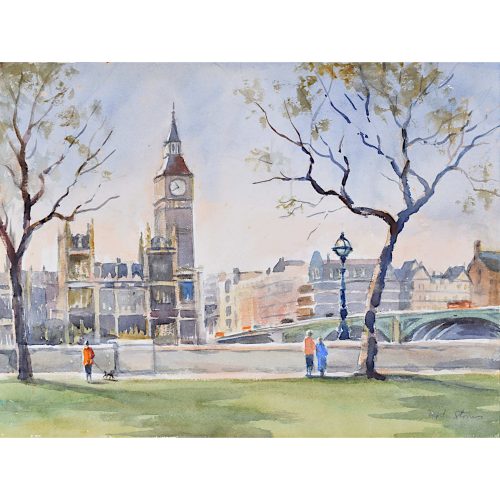
Angela Stones (1914-1995) Westminster Bridge and the Houses of Parliament
Watercolour 31x41 cm Stones was a member of an artistic dynasty. Her mother Dorothy Bradshaw (1893-1983) studied under Jack Merriott - the artist famous for his British Rail posters, and her son, Christopher Assheton-Stones (1947-1999) was probably the foremost pastel artist of his time. If you are interested email info@manningfineart.co.uk or call us on 07929 749056. Condition: Good.

